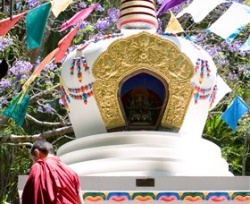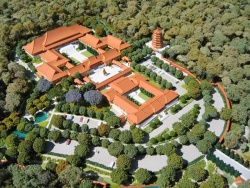The History of Buddhism in Queensland
First Recorded History
Buddhism is reputedly the first non-indigenous religion to arrive in Australia. At a site on the coast of the Gulf of Carpentaria near the base of Cape York, Queensland, a number of Chinese porcelain tea cups, dating 2000 years old, were unearthed several years ago.
In 1961 a 2000 year old vase bearing a crude map of the Australian east coast was discovered in Hong Kong. Another map, dating back 2000 years and drawn on porcelain, exists in Taiwan. It shows the southern coastline of New Guinea, the east coast of Australia as far south as Victoria, and the crude outline of Tasmania. Another Porcelain map has since been found in China. Dating to 1477, it not only describes much of the American west coast, but some Pacific Islands, including New Zealand, Australia and New Guinea, and the islands of south-east Asia and the coast of China.
Thirty-five years ago a jade Buddha was unearthed near Cooktown in far north-Queensland, deep below ancient soil deposits. In Darwin in 1879 workmen dug up a statue of Shou Lao, the Chinese God of longevity, from deep down beneath the roots of an ancient banyan tree. Dating from the Ming period, it has been linked with an expedition believed to have been made to our shores by Admiral Cheng Ho on the orders of his emperor. The fleet consisted of 62 nine-masted ships, each 140 metres in length and accompanied by 28,000 men.
Cheng Ho
Although the earliest evidence of Buddhist influence in Australia is shrouded in mystery, The Chinese Ming Dynasty emperors took a keen Interest in exploration, the first Buddhists are said to have touched Arnhem Land and the Gulf Of Carpentaria, including coastal areas which now Form part of modern day Queensland, with the armada of Cheng Ho in the 15th Century. Cheng Ho also possessed the magnetic compass on this voyage. Invented by the Chinese in 1090, it was not "discovered" in Western Europe for another 100 years.
Cheng Ho sailed from Shanghai in 1405 with orders to visit the islands of south-east Asia on diplomatic and trade matters.
The 1800’s
In the 1800's, especially during the gold rush time, many Chinese people arrived in Australia. Whether any of them were practising Buddhists or perhaps more motivated by Greed is unknown. Certainly, the 1800's saw the first establishment of, so called, "Joss Houses" on Australian soil.
The earliest surviving “Joss House” is the Triad Temple at Breakfast Creek in Brisbane, established in 1885.
1859 – Queensland succeeds from New South Wales
Late 1800’s – Mackay and Thursday Island – The first Buddhists after succession
In approximately 1870, a number of Sri Lankan immigrants, most of whom were Buddhist, settled in the Mackay area of Queensland.
Klaas de Jong revealed in his booklet, "A Short Account of the Spread of Southern Buddhism In Australia and Queensland in Particular", that a group of Sri Lankans arrived in Mackay, Queensland, on board the ship, "Devonshire", on November 16th, 1882. Prior to the voyage, as early as 1876, a large group of Sri Lankans also settled on Thursday Island. By the 1890s, the community totalled about 500 people.
Six years prior to the arrival of the Sri Lankans in Mackay, there was a Buddhist temple on Thursday Island, the northernmost tip of Australia. Klaas de Jong reports that some five hundred Sri Lankans were involved. They were engaged in the pearl trade and they erected a small temple and planted a Bodhi tree. Although remnants of this temple are reputed to have been incorporated into the present post office, the Bodhi tree, apparently, is still thriving. In the book, "Path to Righteousness", a collection of a series of articles by Anagarika Dhammapala, originally published in the Maha-Bodhi Journal' between 1892 and 1900, it is reported that a Dr Worthington formed a group called "Students of Truth", which regarded themselves as 'Christian Buddhists'. This group apparently had branches on mainland Australia, as well as Tasmania and even extended to New Zealand.
Also, in his book "Path to Righteousness", Anagarika Dhammapala talks about these Sri Lankan Buddhists who erected a small temple on Thursday Island, the northern most tip of Australia, during their fishing visits there in the 1890s. The island had been populated for thousands of years by the Melanesian Torres Strait Islanders, who named the island Waiben, thought to mean 'no water or place of no water', owing to the scarcity of fresh water on the island. In 1877, an administrative centre for the Torres Strait Islands was set up on the island by the Queensland Government and by 1883 over 200 pearling vessels were based on the island. A lucrative pearling industry was founded on the island in 1885 attracting workers from around Asia, including Japan, Malaya and India, seeking their fortune.
Like the Chinese, most of the Sinhalese Buddhists returned to their homeland by the end of the nineteenth century. Some remained however and descendants, recognisable by their Sinhalese names, can be found among the members of some present day Buddhist societies in Queensland.
1900’s
Buddhist numbers would have continued to increase if the Immigration Restriction Act of 1901 had not been introduced to combat the ‘yellow peril’. Alfred Deakin, who was destined to be Prime Minister three times, drafted the legislation to pacify a somewhat xenophobic Caucasian electorate. This bill later grew to represent the more broadly implemented White Australia Policy. For the next fifty years the benefits of mind training and Meditation, as taught by Buddhism, would be disregarded as some sort of obscure ‘eastern mysticism’. Except for some remote surviving pockets of Buddhists (such as Broome and Thursday Island), the religion became virtually extinct in Queensland.
19th and 20th Century
The first Buddhist Society of Queensland was founded in 1953, the same year that saw the establishment of Buddhist Societies in Victoria and New South Wales. Unlike its southern counterparts, the Queensland Society was wound up after only three years of activity.
The introduction of Buddhist practice into Brisbane is a very recent event in the 2,500 year history of Buddhism, with the first record of a Buddhist presence dating from the 1880s. Among Brisbane’s Chinese population was a small group who identified themselves as Buddhists. They gathered at Brisbane’s first temple, the Temple of the Holy Triad, which was built at Breakfast Creek in the mid 1880s and remains on its original site. Religious practice at this temple was not exclusively Buddhist, but a blend of Taoism, Confucianism and Buddhism.
By the 1900s, the number of Chinese people in Brisbane and the practice of Buddhism had declined. Although Buddhist immigrants belonging to both the Theravada and the Mahayana traditions of Buddhism have lived in Queensland for well over a century, Buddhist activities to cater to their spiritual needs had taken place before the 1950s, there was no attempt to establish a regular Buddhist organisation to serve the needs of those interested in Buddhism amongst the general population of Queensland.
In 1953 the first attempt was made to organise Anglo-Australian Buddhist activity in Brisbane, through the foundation of the Buddhist Society of Queensland. The high point of the Buddhist Society’s brief period of activity was the April 1955 visit to Brisbane of the first internationally known Buddhist teacher, the Venerable Narada Maha Thera. Despite the success of the visit, the society’s numbers dwindled and it ceased to function after 1956.
The second attempt at organising Buddhist activities in Queensland was the establishment of a short lived Buddhist discussion group in 1962. It was followed by another Buddhist Society but this seems to have been even less of a success than its predecessors and it soon vanished from the scene leaving no trace. Thus when the 1970s dawned, there was no organised Buddhism in Queensland.
The most important influence on the growth of Buddhism in Brisbane was the arrival, from the late 1970s, of immigrants from Buddhist countries. In particular Vietnam, Malaysia, Cambodia and Thailand. In 1974, the world’s first Tibetan-founded Buddhist centre was established at Eudlo in the Sunshine Coast hinterland and remains one of the largest in Australia and the western world.
Buddhism In Queensland Today
In recent years, people’s contact with Buddhism has increased through visits of prominent Buddhist teachers, most notably His Holiness the Dalai Lama. The growth in spiritual and tourist travel to Asia and the influential profile created by Hollywood celebrities like Richard Gere.
The growing appeal of Buddhist Philosophy and Meditation in a changing world has seen the number of Buddhist organizations in Brisbane increase by 10 times - from 4 in 1982, to 40 in 2004 and more than 90 Dharma Centres and Other Organisations at last count. Attendance at the various Buddhist festivals in Brisbane also continues to rise. In 1997, its first year, The Buddha Birthday Festival at South Bank attracted 5,000 people and in 2008 up to 180,000 attended. This celebration of Buddha is Brisbane’s best-attended festival and showcases the growing importance of Buddhism in our wider community. In Queensland today it is possible to encounter a statue of Buddha in the most unexpected of places. While it is impossible to determine when the first Buddha statue would have come to Queensland., the overwhelming Interest and response to Buddhist Principles reveals that today Buddhism is a part of many people’s daily lives.

